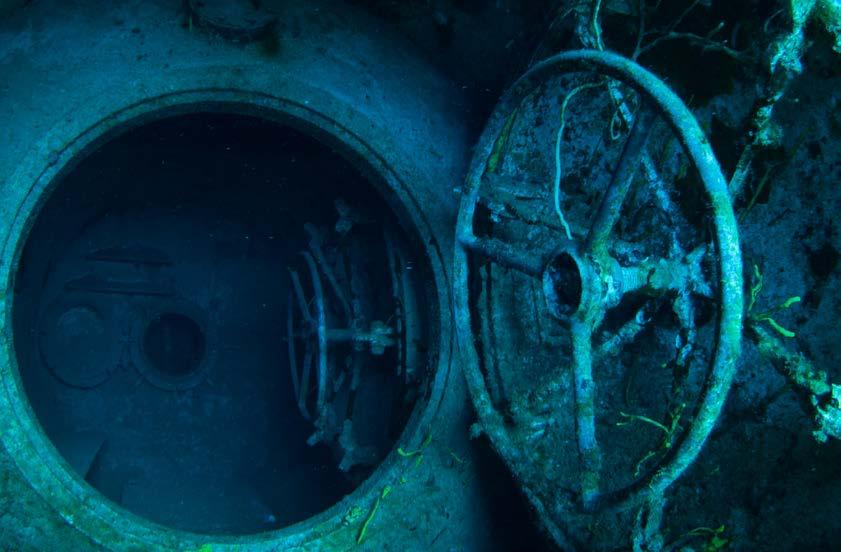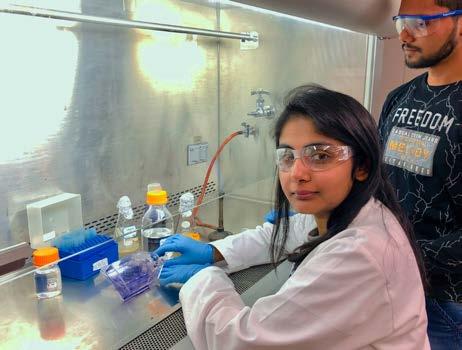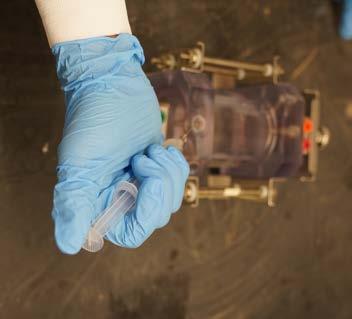
5 minute read
A Titanic Undertaking
A Titanic Undertaking

Advertisement
By Heidi Bell Gease
South Dakota School of Mines & Technology researches bacteria’s effect on deterioration.
The Titanic had barely come to rest on the ocean floor when nature went to work on her. For decades after the 1912 shipwreck she lay in the dark, icy depths of the North Atlantic, eventually being discovered in 1985.
Several exploratory excursions visited the site in the years that followed. But when the first manned voyage in nearly 15 years arrived at the wreckage last August, explorers were shocked to discover how much the ship had decayed.
The liner’s grand staterooms and officers’ quarters were gone, victims of metal-eating bacteria.
The same bacteria can wreak havoc with everything from off-shore drilling platforms to county bridges. And while the Titanic’s deterioration came as a shock to many, it’s nothing new to a group of scientists at South Dakota School of Mines & Technology (SDSMT) who are conducting a five-year research project on the subject.

Tanvi Govil conducting research

Tanvi Govil conducting research
“We are doing (research on) exactly what the Titanic is undergoing,” said Dr. Govind Chilkoor, who is part of a team working to understand the aggressive chemical and biological processes that break down metals. Their work involves seeking better alternatives to the polymer coatings that are currently used to coat and protect exposed metals.
The research project is funded by a National Science Foundation CAREER Grant. The program supports early-career faculty scientists who have the potential to serve as academic role models and to lead advances in their fields of study. Dr. Venkataramana Gadhamshetty, an associate professor of civil and environmental engineering at SDSMT received the five-year, $500,000 CAREER grant in 2015 and oversees the research team.
This proposal grew out of another research project Gadhamshetty was involved in that involved using wastewater to generate electricity in microbial fuel cells. During those experiments Gadhamshetty’s team found that corrosion of nickel foam by microorganisms could be stopped or slowed when the nickel was coated with two layers of graphene, which is a 2D form of graphite. That discovery is the subject of the current research.
The research is fascinating and Chilkoor explains it well. For years the industry standard has been to use polymers to protect metals from corrosion, he said, but those polymers have shortcomings. They’re very porous, which allows corrosive ions to pass through and attack the metal. They don’t adhere well in water and bacteria actually like polymers.
2D materials are different. Graphene is a one-atom layer of graphite. The space between the atoms is so tiny corrosive materials can’t pass through it. And while thickness usually equates with strength, “the astonishing thing about 2D materials is that this graphene has higher strength than graphite,” Chilkoor said.
2D materials are also thousands of times thinner than polymers. They’re transparent on metal, which makes it possible to see what’s happening underneath. But 2D coatings could be difficult to ship and to apply, making them impractical for commercial use. However, researchers have found that adding less than 1 percent graphene to other polymers can more than double the protection those polymers provide.
That could translate to big savings by extending the life of ships, platforms and other metals that live in the sea. Currently “corrosion costs the U.S. $1 trillion each year,” Chilkoor said. About 20 percent of that destruction is due to micro biologically influenced corrosion.
Microbes create a layer of biofilm on the surface of underwater metal, using electrons from the metal for energy. Biofilms attract corals, sponges and other organic substances that can form acids which also attack and weaken the metal.
Chilkoor said these bacteria “are very silent in nature,” creating localized corrosion and pitting the metal beneath the biofilm. It’s like drilling multiple holes in a wall until the wall – or, in recent news, a piece of the Titanic - collapses.
Research often raises as many questions as it answers. Microbiologist, Dr. Jawahar Raj Kalimuthu joined the research team in 2018 to look at genetics of the biofilm communities and how they function.
This research project could easily lead to others. It’s possible that 2D materials such as graphene could be melted right into metal to make it stronger; there may also be potential medical uses for 2D materials that prove to be antimicrobial.
“It’s a very exciting area,” Chilkoor said. “It’s been a very, very satisfying experience for me.”
It’s also been a great experience for graduate student Shane Star, who joined the project in 2015 as an undergraduate in civil engineering. Chilkoor said Mines researchers wanted to encourage Native American students to enter the research field and this grant allowed them to do that. Star, who is from Pine Ridge, has progressed to where he can work on the research independently. He was also a third author on the team paper published in ACS (American Chemical Society) Nano, a highly-respected research journal.
“It’s been awesome,” Star said. “It was (research) I actually got to see happen.”
The project has inspired Star, Chilkoor said. “Hopefully he’s going to inspire a lot more.”
From the looks of it there will be plenty of things to explore. BHB

Biofilm research facility at SDSMT
SDSMT Leads Research
Microbes may be tiny, but they’re making a big impact on South Dakota School of Mines & Technology.
In the past three years the National Science Foundation has awarded $32 million in grant funding for research led by SD Mines faculty that focuses on microbes – in particular, the environment microbes create when they attach to surfaces. Studies of this environment, known as a biofilm, have the potential to improve corrosion resistance (see related story), improve agricultural and energy production, reduce greenhouse gas emissions, improve water purification methods and create new medicines and materials, according to a news release from SDSMT.
On Sept. 24, officials announced a new $20 million NSF grant, “Building on the 2020 Vision: Expanding Research, Education and Innovation in South Dakota,” to be led by researchers at SDSMT, South Dakota State University and the University of South Dakota. Funding was awarded through the South Dakota Established program to Stimulate Competitive Research and the South Dakota Board of Regents. The State of South Dakota is providing $4 million in matching funds for the grant, including $3 million from the Governor’s Office of Economic Development and the SD Board of Regents and $1 million from SDSMT, SDSU and USD.
The NSF grant will pay for scientific equipment and allow for the hiring of additional scientists at SDSMT, SDSU and USD.
SDSMT President Jim Rankin said the cutting edge research has huge potential benefits for the state and regional economies. “This is an investment with the potential to pay itself back many times over in the creation of new startups and high-tech jobs that spin off from the discoveries that are made,” he stated in the news release.
A related $6 million grant, “Data Driven Material Discovery Center for Bioengineering Innovation,” will allow researchers at SDSMT, USD, Montana State University and the University of Nebraska-Omaha to catalogue, organize and analyze large amounts of data generated in the biofilm research.
A third $6 million NSF grant, known as BuG ReMeDEE Initiative, was announced in 2017. It involves research into the microbes found in the depths of the Sanford Underground Research Facility in Lead.
The grants also include education components, with funding to train K-12 teachers in how to implement new STEM-based hands-on curriculum. BHB


